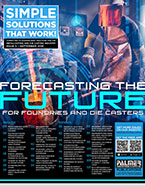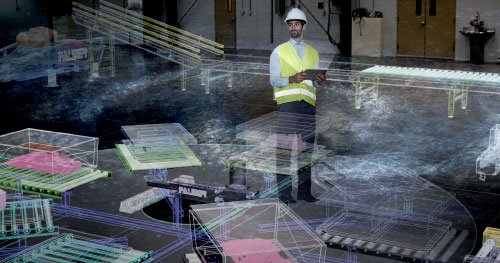Foundry & industrial processing Machinery EQUIPMENT & SYSTEMS
U.S. & Canada Call 1.800.457.5456
GREENER, CLEANER, LEANER, MORE PRODUCTIVE MACHINESFOUNDRIES OF THE FUTURE
Home Articles GREENER, CLEANER, LEANER, MORE PRODUCTIVE MACHINESFOUNDRIES OF THE FUTURE

Simple Solutions That Work!™, Volume 5, September 2016
Written by Ken Strausbaugh
Ken Strausbaugh
Technical & Testing Manager
Palmer Manufacturing & Supply, Inc.
Article Takeaways:
The foundry of the future will likely continue the trends of the recent past. Most of foundries of today are, greener (fewer emissions), cleaner (less particulates in the working environment), leaner (personnel performing multiple tasks), and more productive (higher tonnage per man hour) than in the past.

There are going to be continued pressures from the public and consequently from the regulators to minimize degradation of the environment in the future. This will include solid waste, air emissions, waste water, and storm water. Foundries will be required by law, the neighborhood, or pressured by costs to reduce sand disposal and the emission of anything that is considered a pollutant – particulate matter, sulfur dioxide, carbon dioxide, nitrogen oxides, volatile organic compounds, and metal fumes. Emissions from chemical binder systems will receive greater scrutiny in the future. The world is becoming more sensitive to environmental issues and foundries will need to adapt. Compliance has a cost but there can also be savings in reduction of inputs (energy efficiency, sand use, chemical consumption) which all reduce emissions.
The internal foundry environment will be cleaner. The recent regulations relative to silica exposure requires changes to processes that contribute to airborne silica. Dust collection equipment and the maintenance of it will have a higher priority. The prohibition of using compressed air to blowing out molds may contribute to the use of equipment that doesn’t just blow dirt from one mold to another. Cleaner foundries may make it easier to attract and retain employees. Effort will be required to maintain a cleaner foundry environment but there is still potential to actually be a better foundry because of it.
A leaner better trained workforce will be essential. Foundries in the U.S. cannot compete with the lower wage levels acceptable in some other parts of the world so employees must contribute more per hour. Hourly labor costs do not need to be matched precisely because shipping costs must be added to the foreign competitors cost as well as the response time and ultimately the environmental costs of freighter transport will be included. However, a more knowledgeable well trained workforce is the first step in producing good castings at the minimal cost. Most schools cannot teach the fundamentals required for the foundry industries beyond the basic reading, writing, and arithmetic. Each successful foundry will incorporate training programs beyond the required safety programs to upgrade the employee’s skills. The employees will know how to monitor automated equipment so that it doesn’t generate more defects and scrap than manually operated tools while maintaining near 100% up-time. Employees will have a better understanding of the casting process from raw materials, through molding, melting, pouring, finishing, machining, inspection, and shipping. A lean, well trained workforce will help to reduce costs essential to competing with low cost/hour labor.
Foundries of the future will continue to become more automated and machine intensive. Advances in robotics will eliminate some of the work done by people. 3D printing will reduce experimental tooling costs and reduce development time for some castings. Some low production highly complex castings will be made using 3D printing. Any automation must reduce labor costs and maintain or improve quality making the foundry more competitive. Safety will be of high importance as the automated equipment doesn’t always recognize the presence of personnel. The finishing departments will see a dramatic reduction in manual chipping and grinding. Manipulators and robotics along with other automatic grinding machines will eliminate many of the difficult, tiring, and sometimes hazardous finishing jobs. More foundries will provide the final customer with a ready to use casting. The foundry will get quicker feedback regarding final casting quality and should be able to remedy problems without impacting the final customer.
Many of the specific changes suggested for the future may be not be incorporated and maybe some unforeseen countermeasures will be instituted but surely the foundry of the future will be greener, cleaner, leaner, and more productive. This is just a continuation of the progress over the generations.
Copyright © 2025 Palmer Manufacturing & Supply, Inc. | Terms and Conditions | Privacy Policy




